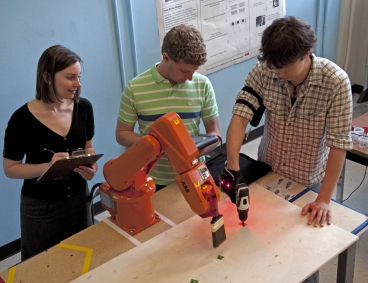By Kalwinder KaurJun 13 2012
MIT’s Boeing Career Development Assistant Professor of Aeronautics and Astronautics, Julie Shah stated that in future handling of common tasks, the factory floor may have robots working alongside humans. Shah predicts that airplane manufacturing can be effective with robotic assistants.
 Professor Julie Shah observes while grad students Ron Wilcox (left), and Matthew Gombolay coordinate human-robotic interaction (Photo: William Litant/MIT)
Professor Julie Shah observes while grad students Ron Wilcox (left), and Matthew Gombolay coordinate human-robotic interaction (Photo: William Litant/MIT)
Robots will be controlled by a set of preprogrammed instructions for a repetitive task, while working individually. But while working with humans, robotic assistants will adapt to specific behaviors of humans.
A new algorithm has been formulated by Shah and her student team at MIT, through which a robot can study the preference of an individual for a specific task and subsequent adaption to conclude the task. Based on algorithm’s simulations, the students can train robots and humans to work in sync. These findings will be presented at the Robotics: Science and Systems Conference in Sydney during July.
Shah’s team performed a test case on spar assembly of an aircraft’s wing. Two pieces of the wing are aligned in typical manufacturing process. According to the researchers, robots such as FRIDA from ABB may be programmed to aid in the spar-assembly process. FRIDA is a versatile robot consisting of two arms that can move either way based on the operator’s preferences.
In order to establish sync between robot and human’s actions, the group developed a computational model resembling a decision tree. Each branch of the tree represents a potential choice for the mechanic. Human experiments were performed by the team based on this model, wherein a laboratory robot was programmed to observe an individual’s series of preferences, followed by quick adaptation with respect to an individual’s specific style of work.
Disclaimer: The views expressed here are those of the author expressed in their private capacity and do not necessarily represent the views of AZoM.com Limited T/A AZoNetwork the owner and operator of this website. This disclaimer forms part of the Terms and conditions of use of this website.